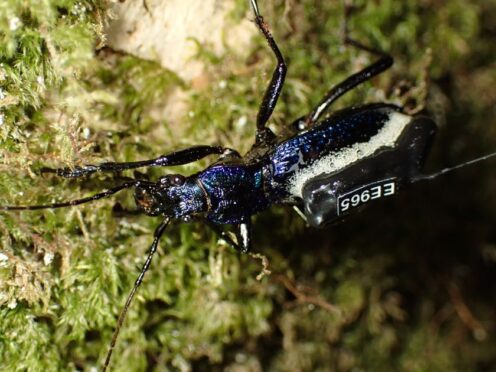Scientists have put “mini backpacks” on rare beetles found in temperate rainforest fragments to record their movements as part of a study that could help to support conservation efforts.
Researchers from the University of Exeter have been working with the Woodland Trust to examine the blue ground beetle, an elusive animal that lives in the habitat in south-west England, and about which little is known.
The team delicately placed radio trackers, which look like small backpacks, on 36 of the insects to record their daily comings and goings in various woods across Dartmoor.

They found that some beetles were faster and more adventurous foragers than others, with some venturing out for multiple days before returning to their refugia (base).
One was found to have scaled kilometres at night in search of food and mates, according to the findings.
The researchers, who were led by Dr Nick Royle with PhD researcher Brogan Pett, said the study could provide “essential” insight into how the Woodland Trust and other conservationists might protect and restore these rare habitats in the face of climate change.
Dr Royle said: “Blue ground beetles are one of the largest and rarest species of ground beetle in the UK with a very restricted distribution, mostly on Dartmoor.
“However, we know relatively little about its biology, particularly how it uses the habitat it is found in and what characteristics are essential for it to thrive.

“Such knowledge is essential to be able to develop successful conservation practices to boost populations, which are currently highly fragmented.”
Mr Pett said: “Individuals varied considerably in how active they were and how much they moved around the forest.
“One male whose tag number happened to be R9 turned out to be a real athlete, just like his namesake, Ronaldo, travelling large distances within the forest each night, which is the scaled-up equivalent of several kilometres.”
Mr Pett said the beetles are only active for a few months a year during warm, humid evenings in late spring and early summer to feast on slugs and to search for mates.
“Our radio-tracking revealed that they also prefer to stay away from the outside border of their woodland habitat, with individuals resting up during the day in mossy logs of decaying deadwood or in cracks in trees in shady parts of the forest,” he added.
Sam Manning, Woodland Trust site manager of the trust-owned Bovey Valley Woods where some of the study has been carried out, said: “The data from the project will help inform vital decisions about how we manage our precious rainforests.

“Blue ground beetles are an important indicator of a healthy rainforest here in the South West so we can see exactly what it is they need to thrive and repopulate.
“It will help us to create a resilient landscape and establish what scale of woodland habitat restoration and new connections are needed to help build that resilience.”
The Woodland Trust is working with various partners in the South West, Scotland and Wales to form multi-partner alliances to help protect temperate rainforest environments for the future.
